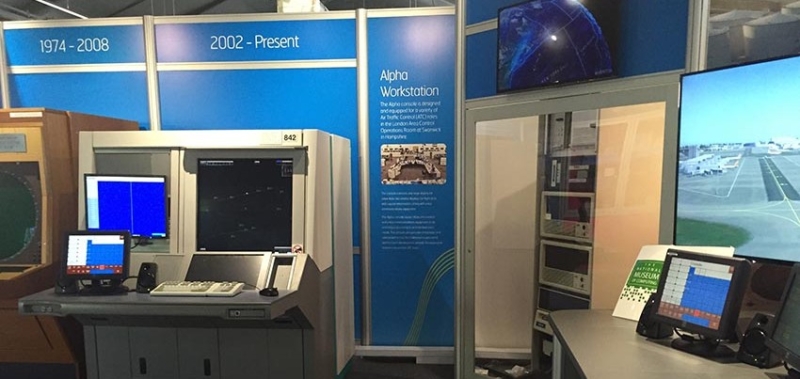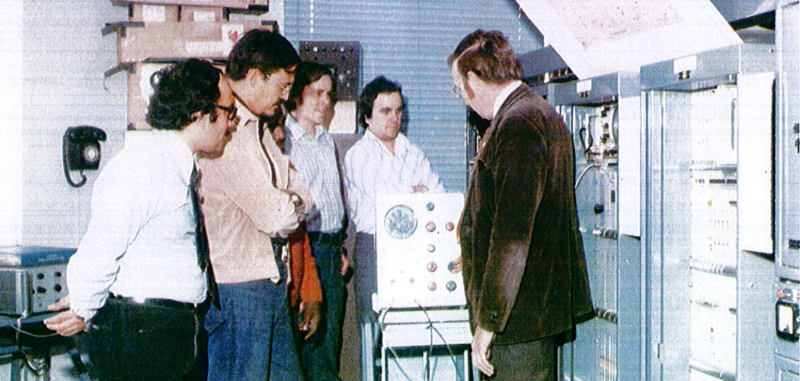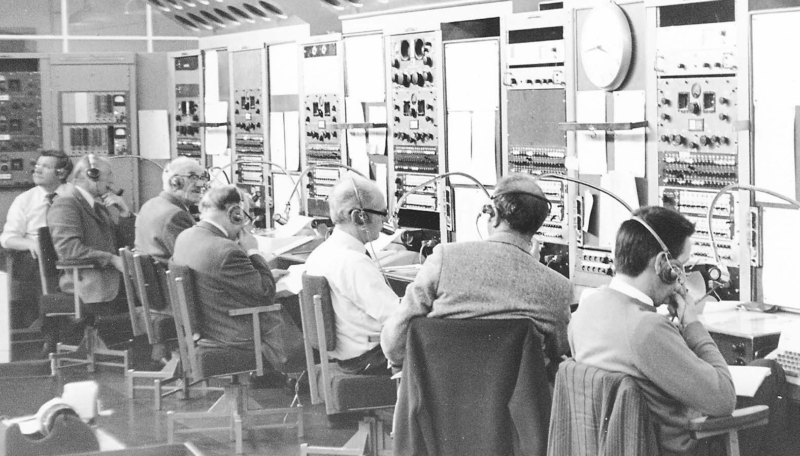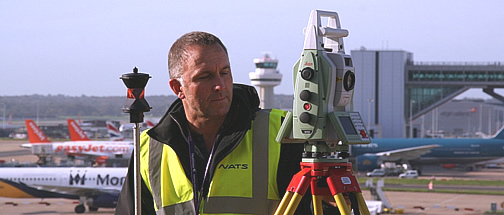The journey of computing in ATC
15 May 2015As we open the new “Computers in Air Traffic Control” gallery at the National Museum of Computing, Bletchley Park, it seems a good time to reflect on the developments in air traffic control over the last 40 years that has been enabled by computer technology.
We’ve come a long way from dimly lit operations rooms with controllers hunched over amber glowing radar displays, with Bakelite headsets and even ashtrays on the workstations. Today’s operations rooms are bright, airy places with data displayed on high definition display screens and controllers using the very latest computer technology to support them. The basics of using Radar to detect the current position of aircraft and radio to talk to the pilots hasn’t changed too much but there has been a revolution in the data and data processing systems supporting our air traffic controllers.
All pilots file a flight plan before they enter our airspace. In the 1970’s we deployed a large IBM mainframe computer known as the “9020” to process these flight plans, correlate the radar data with the flight plans and to let the controllers know which aircraft would be in which parts of our airspace at what time. This computer support allowed controllers to safely handle more aircraft as business and leisure travel took off. The controllers received printed details for each aircraft on paper flight strips – though the mainframe computer had to be shut down every night for maintenance. About 10 o’clock each evening we would ask it to print out all of the flight strips for the night shift.
As computer power increased and the skies became even busier we were able to start predicting the future – we started to track aircraft and calculate where they would be in the next 2-3 minutes so that we could help the controllers spot any aircraft that could get close to each other – we called this Short Term Conflict Alert. Paper strips have largely been replaced with electronic data lines allowing controllers to enter data on their screens. Dozens of parameters from the flight computer on the aircraft are downlinked via our radar systems and controllers can now send control instructions to the flight deck via datalink messages.
Processing all this extra data takes a lot of computing power – millions of calculations every second taking into account aircraft type, weight, windspeed, temperature and controller instructions – but it means we can now predict the position of aircraft up to about 20 minutes into the future very accurately and plan the most fuel efficient paths for the aircraft to safely get to their destinations.
Our journey continues as we work on improvements to provide the capacity, fuel efficiency and resilience for our customers using the latest in computer technology. I’m not sure that Alan Turing, and the original Bletchley team, could have imagined what their computer would enable in the future.
The display at the National Museum Computing has a controller workstation from the 1980’s alongside a state of the art simulation of systems from the Swanwick Centre and a busy airport tower. We’ve added some historical artefacts and a timeline of NATS linkages with Bletchley Park to celebrate our joint heritage. If you are interested in computers or air traffic control, the museum is an excellent day out and if you visit I hope you enjoy what we’ve put together.
Comments
Please respect our commenting policy and guidelines when posting on this website.








29.03.2020
14:57
Bert Hayes
Interesting article. I joined NATS or NATCS as it was in 1968 and was posted to West Drayton as an Air Traffic Control Assistant before four years later being selected for an air traffic control cadet course.
The computer then was “Minicap” and housed in big grey cabinets in an adjacent room to the Ops room.
In essence it was a calculator. From my memory it was overseen by a gentleman named Ray, cannot remember his surname. Wind forecasts were typed into the program and strip printers produced strips with estimated times for aircraft between the Vors on the airways, Green 1, Red 1 etc. If I remember rightly it was switched off each Tuesday for maintenance and we resorted to producing hand written flight progress strips for the procedural controllers sitting on a North Bank and South bank. Radar was situated on the north side of Heathrow airport. In calculation times for aircraft between beacons you had a strip card with times between the beacons based on speed i.e 180knots equalled 3nm a minute! Interesting times. I was on the night duty when we all moved into the new ops room with the flat topped radars and the 9020d system but that as they say is another story!
20.03.2021
23:30
Bill pye
I remember it well. It was crazy to switch off the computer each Tuesday. Minicap was also an innovation as well in the early days of computing in Nats. Brian was working on it as well. I wor kin ed on the 9020D.
30.08.2023
18:55
Simon Davies
I spent about 15 months in the late 1980s replacing the disk drives from the flight routing computer in the control tower at Heathrow. The disks were (I think) Burroughs and were 4-foot cubes with another cube for power, air supply and cooling and had 4 disks totalling 20MB. I believe that they were installed in the mid 1960s, I replaced them with a bespoke interface solid state drive, more capacious and faster.
However I was trying to remember the supplier of the mainframe that used the drives – I am reasonably sure it wasn’t Burroughs and that it had beeen installed earlier. I do recall that it had dozens of printed circuit boards covered with discrete components and DTL ICs.
Any takers for the mainframe name?
I really enjoyed working on site at the tower, I can still picture many faces but no names come to hand now.